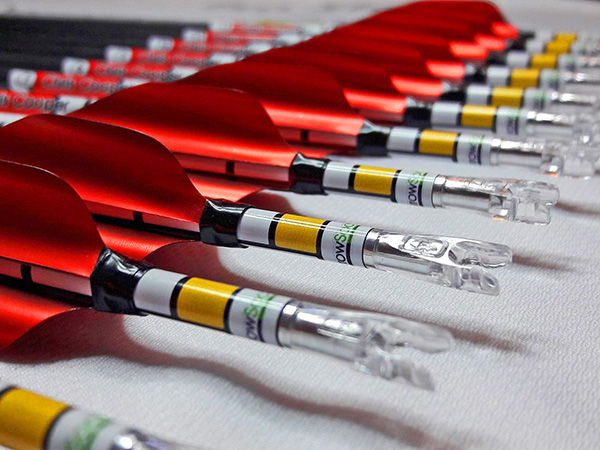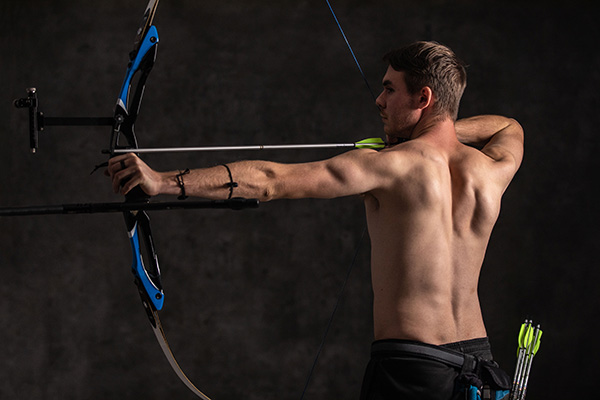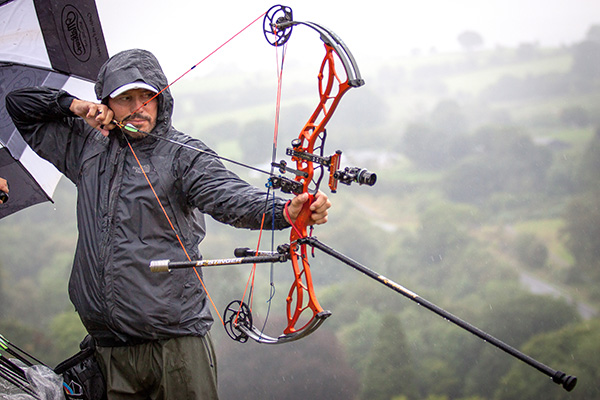Our panel of expects from around the world answer your questions on every aspect of shooting technique, phycology and equipment.
Question:
How do I know when to change my nocks?
Adrian Tippins says:
The obvious answer is to change your nocks when they become damaged, but that’s not the whole story. Arrows should be inspected for damage before and after every shoot. This maximises the chances of identifying any damage at the earliest possible opportunity.
There are a few tell tale signs that can lead you to the possibility that a nock needs replacing. Firstly, if an arrow keeps falling out of the bow, inspect the ears of the nock and the groove between them. The nock may have received an impact, which might widen the groove. Make sure the ears are consistent and don’t have any burrs or gouges from arrow strikes. Sharp defects such as this are likely to cause damages to the string serving and will chafe it to the point where it frays and unwinds.
Any nock that used to fit tight on a nock pin but now seems loose is also suspect. This tends to be symptomatic of having a hairline crack that is widening the aperture. An insert nock that has become loose is normally down to a crack in the arrow and/or a loose bush.
Another reason for changing nocks can simply arise from changing your string or arrows. The nock should always be a good fit for the string and release without plucking it. The nock should also not rotate too easily on its pin or in a bush. There are fine differences between brands which do affect compatibility and fit. For example a Beiter pin nock fits loosely on an Easton Pin but more snugly on a pin by Carbon Express.
Easton fits well on Easton but quite tight on Carbon Express. Bohning seems to fit well on most brands of pin. Nock to pin fit is critical for energy transfer and for not letting the nock indexing go out of alignment
When choosing nocks it can be an advantage to opt for a translucent style nock. This makes spotting small cracks much easier than on solid opaque colours. Plastic gets brittle over time due to the nature of it’s chemical composition. This takes a long time though, and nocks will last a very long time before suffering structural failure.
Usage, storage and shot cycle are all factors that can affect the lifespan of a nock. Manufacturers go to great lengths to computer design the geometry of nocks to eliminate weak points and then test them to destruction. It’s not just the bow’s power output that the nocks have to withstand but also the large amounts of kinetic energy produced from the very sudden stop of hitting the target.
As nocks are a relatively inexpensive item compared to the rest of your archery kit, it doesn’t hurt to change them every season or two depending on your level of activity.
Question:
I’m a casual archer, and I can feel knots in my back developing. Please help!
Vanessa Lee says:
Feeling knots in muscles is completely normal and more common than you’d think. I would bet a lot of money that if you jam your thumb into your friend’s upper traps right now, they would probably jerk away from you and if you keep doing it, they might not be your friend for much longer. It’s important to know that knots are completely normal because I want to reassure you that they’re not something sinister, and not something to be afraid of.
The knots I think you’re feeling are also often called myofascial trigger points. When you get a bunch of myofascial trigger points and it causes more pain, we call it myofascial pain syndrome, basically a fancy way of saying it just hurts more now.
So, what is it? Your muscles aren’t actually in knots even though it feels like it. Although research does not fully understand myofascial trigger points, the most popular explanation is that it’s a small patch of tightly contracted muscle that impacts its own blood supply, leaving the area in a bit of a metabolic mess.
Myofascial trigger points are more likely to occur in muscles that are used repetitively and lift heavy loads (basically, everything our sport requires of us). The problem with knots in your muscles is exactly what you said – it’s simply not comfortable.
The most popular way of treating trigger points is through self-treatment. Self-massage, foam rolling, and getting more specific points with rolling on a lacrosse ball can potentially help relieve your discomfort. You can start by finding the trigger point and pressing directly on it (or getting a helpful friend to) for anywhere from 10 seconds to a minute, depending on how irritable it is and what you feel is helpful.
You can also try kneading the trigger point in different directions. If you know the direction the muscle fibres travel, you can try running parallel to them because I find that more comfortable and you might find that to be more effective. You can apply the same principles for self-treatment using a foam roll or a lacrosse ball.
The most important factor in self-treatment would be the intensity – or how hard you’re pressing. I’m sure you’ve heard the phrase “no pain, no gain”. To tell you the truth, I really don’t agree with this. It’s acceptable to feel some discomfort but you shouldn’t be seeing flashbacks from your childhood.
On a scale of 0 to 10, with 10 being the worst pain imaginable, I’d suggest aiming for a range between 4 and 7. You can gauge intensity for next time based on how you feel the next day. Is it still sore? Maybe try backing off the intensity just a bit. Is it feeling a bit better? Keep it up! There are other options such as massage, manual therapy, acupuncture and tools like the TheraGun, but I’d recommend trying to self-manage first.
It’s important to keep in mind that pain is complex and is not always about physical symptoms in our bodies. If you don’t find relief, find a healthcare professional that understands pain and will give you the tools you need to manage in the future. Remember that your body is strong and resilient.
Disclaimer: This is not intended to be a substitute for professional medical advice, diagnosis or treatment. Seek out a qualified healthcare professional with questions regarding your health or medical condition.
Question:
Does it matter which way a compound arrow spins?
James Park says:
It is a good question. Firstly, we can be confident that we do want an arrow to rotate since it markedly improves accuracy. I have conducted a number of tests of arrow grouping with and without rotation and have modelled it mathematically, and the groups will be smaller for an arrow that rotates. That makes sense because we are averaging out residual imperfections. I would like my arrows to rotate at least a couple of times in the shortest distance I shoot – that is, at least several rotations in the first 10 m of flight.
Secondly, given that we do want them to rotate, is one direction better than the other?
I often hear that one direction is preferred because it helps with clearance. However, the arrow cannot start to rotate until the nock separates from the string and then there is very little time, especially for a compound bow, for any arrow rotation prior to the fletches passing the launcher or pressure button. At most, the rotation in that time is only a degree or so and that can be easily accommodated by selecting a suitable nock orientation. For this reason, I do not see that aspect as important in setting a preferred rotation of direction.
It can be easily demonstrated that some arrow types have an inherent rotation as they leave the bow – take an unfletched arrow, mark the top, and shoot it from a couple of metres into a target butt. For example, all the woven carbon arrows I have tested did rotate.
I am certain that this is a feature of the arrows, not of the bow. Every arrow that I have tested, and which did rotate, did so counter-clockwise as seen from behind. Some arrows I have tested did not rotate – for example, those with longitudinal carbon and an aluminium core.
The arrow’s fletch angle determines the direction of arrow rotation down range. Where that is counter to the arrow shaft’s inherent rotation, I have seen video showing an arrow exiting the bow rotating one direction, the rotation slowing, and then starting to rotate in the direction dictated by the fletches.
It seems to me to be better to go with any inherent direction of arrow rotation. That saves a little arrow energy and increases the rotation rate during the first portion of the arrow’s flight. Consequently, for many arrows I expect it would be best to arrange the fletches so that the arrow rotates counter-clockwise as seen from behind.





About first question and answer: ” …opt for a translucent style nock. This makes spotting small cracks much easier than on solid opaque colours. ”
I’m sorry but I disagree. Damage, thin cracks, are much easier being spotted on opaque nocks then on translucent.